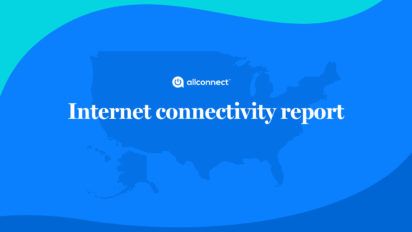Key findings
- The average price for home internet in urban areas is $83.75/mo.
- People living in cities currently receive 365 Mbps download speeds on average — nearly twice what they were getting in 2019.
- Since 2019, the average price per Mbps in U.S. cities has decreased from $0.42 to $0.23.
- 5G providers like T-Mobile and Verizon are the fastest-growing options in U.S. cities.
- Nearly 1 in 4 households in the U.S. now subscribes to fiber internet.
When it comes to internet in the U.S., urban residents have long enjoyed faster speeds and lower prices than their rural counterparts. An analysis of Federal Communications Commission (FCC) data shows that people living in cities have seen their internet speeds virtually double over the past half decade, while prices have barely budged.
Fiber internet has continued its steady march across U.S. cities, while seemingly overnight, wireless companies like Verizon and T-Mobile began utilizing their 5G networks to offer high-speed home internet. In many cities, residents now have several internet providers to choose from.
On this page:
- Customers in cities are getting faster speeds for roughly the same price
- Fiber customers in urban areas get the best value for their money
- Fixed wireless and fiber are the fastest-growing connection types in cities
- Average price by internet provider
- States where urban residents pay the most and least for internet
- Our methodology
Customers in cities are getting faster speeds for roughly the same price
Over the past five years, the average price for home internet service has hardly budged in American cities. In fact, the real cost has actually gone down — the $76.83/mo. average bill in 2019 would be equivalent to $91.23/mo. in 2023 dollars.
What has changed in the same period is the speed that customers are receiving. Since 2019, average download speed in urban areas has doubled, going from 183 Mbps to 365 Mbps. So what’s driving this explosion in internet speeds?
With prices staying relatively flat, Americans aren’t necessarily upgrading to faster plans. Instead, more people simply have access to faster broadband connections like fiber internet and 5G home.
Fiber internet is now available to 37% of U.S. households, compared to 30% in 2019, and new 5G home providers like T-Mobile and Verizon have offered a massive speed upgrade for many customers.
Fiber customers in urban areas get the best value for their money
- Across all internet types, the average price per Mbps paid by broadband subscribers has decreased from $.42 to $.23 — a 45% drop.
- Fiber internet provides the best value of any connection type, with a 2023 price per Mbps of just $0.12.
- Fixed wireless customers are now getting twice as much speed as they did in 2019 for the same price. This is primarily due to the proliferation of 5G home internet providers like T-Mobile and Verizon, which offers download speeds up to 300 Mbps for just $50/mo.
- DSL is the only technology that hasn’t seen a significant drop in price per Mbps, going from $1.85 in 2019 to $1.63 in 2023.
Fixed wireless and fiber are the fastest-growing connection types
- Fixed wireless providers (5G) like T-Mobile and Verizon have been incredibly popular since they launched, adding 3.1 million new subscribers in 2022 — up almost 3.5x from 2021.
- In 2019, fiber was available to around 30% of U.S. households, and 20% subscribed. Availability expanded to 37% in 2023, with 23% of the country subscribing.
- DSL is the connection type that’s losing customers the most rapidly, as many providers have begun phasing out their DSL service.
- Cable internet shows a slight decrease since 2019, but is still the most popular connection type.
How much does each internet provider charge?
- Buckeye Broadband is the most expensive broadband provider in urban areas, with an average bill of $224.08/mo. That price is nearly double what it was in 2019.
- Atlantic Broadband (now called Breezeline) currently has the lowest broadband prices at $56.73/mo.
- Verizon has seen the largest price decrease since 2019, cutting its average plan price nearly in half.
| Provider | Average 2019 price | Average 2023 price | Percent change |
|---|---|---|---|
| Altafiber | $73.63 | $100.26 | 36% |
| Astound/RCN | $129.44 | $165.60 | 28% |
| AT&T | $70.29 | $79.42 | 13% |
| Atlantic Broadband | $85.74 | $56.73 | -34% |
| Buckeye Broadband | $115.49 | $224.08 | 94% |
| CenturyLink | $54.09 | $69.78 | 29% |
| Frontier | $64.76 | $61.94 | -4% |
| Google Fiber | $56.94 | $84.19 | 48% |
| Mediacom | $104.99 | $64.15 | -39% |
| Optimum/Suddenlink | $106.43 | $77.64 | -27% |
| Spectrum | $66.53 | $72.57 | 9% |
| Verizon | $148.32 | $79.98 | -46% |
| Windstream | $66.14 | $73.76 | 12% |
| Xfinity | $86.86 | $73.19 | -16% |
Which states pay the most and least for internet?
- Over the last five years, the average state has paid $80.31/mo. for a download speed of 281 Mbps in urban areas.
- Residents in Utah cities have gotten the most value for their internet, paying just $0.10 per Mbps.
- Montana residents in cities pay the most — $108.02/mo. for 87 Mbps download speed on average.
The bottom line
Adjusting for inflation, the price of internet service has effectively gone down for most people living in cities across the U.S. This is primarily due to technologies like fiber and fixed wireless expanding to new markets, giving customers more options for home internet. Most people are actually getting much faster speeds for those prices, too — download speeds in cities have increased from 183 Mbps in 2019 to 365 Mbps this year.
Our methodology
For this report, we analyzed data from the FCC’s annual Urban Rate Survey, which asks over 36,000 respondents in urban areas questions about their internet plans. The speeds referenced in this report are the advertised speeds listed to the respondents.
For researchers and journalists
If you would like to know more about this topic, we can assist you. Our experts can help you dig deeper into the data.
Email our experts
Written by:
Joe SupanPrincipal Writer, Broadband Content
Joe is a senior writer for CNET covering home technology and broadband. Prior to joining CNET, Joe led MYMOVE’s moving coverage and reported on broadband policy, the digital divide, and privacy issues for the br…
Read more
Edited by:
Robin LaytonEditor, Broadband Content
-
Featured
![100% of KS and RI residents have broadband access. Where does your state rank?]() 100% of KS and RI residents have broadband access. Where does your state rank? Joe Supan — 5 min read
100% of KS and RI residents have broadband access. Where does your state rank? Joe Supan — 5 min read -
Featured
![Report: Internet users are gobbling data by more than a half-terabyte]() Report: Internet users are gobbling data by more than a half-terabyte Robin Layton — 4 min read
Report: Internet users are gobbling data by more than a half-terabyte Robin Layton — 4 min read -
Featured
![Americans are getting over 244 Mbps in download speed, but are you?]() Americans are getting over 244 Mbps in download speed, but are you? Robin Layton — 7 min read
Americans are getting over 244 Mbps in download speed, but are you? Robin Layton — 7 min read
Latest
-
Thursday, July 25, 2024
Worried about losing your signal? This is how to keep your satellite dish cleanDavid Anders — 6 min read
-
Tuesday, July 23, 2024
The best free TV and movie streaming services 2024Camryn Smith — 5 min read
-
Tuesday, July 23, 2024
Everything you need to know about internet speedsRobin Layton — 8 min read






